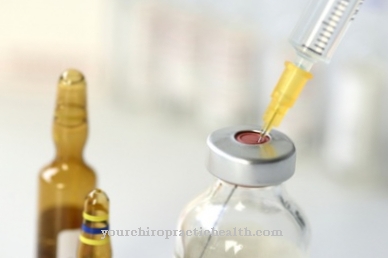Bleomycin is a glycopeptide antibiotic with cytostatic properties. It is used for squamous cell carcinoma, Hodgkin and non-Hodgkin lymphoma, testicular tumors and malignant pleural effusions. Special side effects under bleomycin therapy, especially with overdose, are pulmonary fibrosis and skin damage.
What is bleomycin?
The drug bleomycin is a cytostatic drug that damages human DNA by breaking the DNA strand. There are two structurally similar glycopeptides in the bleomycin mixture, the derivatives bleomycin A2 and B2, with the derivative A2 having a higher proportion of 55-70%.
The active ingredient is obtained from the actinomycete Streptomyces verticillus, which means that it belongs to the group of antibiotics.
Pharmacological effect on the body and organs
Bleomycin is administered intravenously (via the vein), intramuscularly (into the muscle) or intrapleurally (into the chest cavity), depending on the disease. After intravenous drug administration, elimination in the blood plasma occurs rapidly, which proceeds biphasic. The half-life is initially 24 minutes and then increases to 2 to 4 hours.
The substance is inactivated by hydrolases and other low-molecular protein fractions, which are mainly found in the blood plasma, but also in the liver. However, these hydrolyses occur to a lesser extent in the lungs and skin. Bleomycin is ultimately excreted by the kidneys but cannot be removed via dialysis.
The formation of superoxide radical anions is the main mechanism in the action of bleomycin. In the cell it forms a bleomycin-iron (II) complex with iron (II) ions, which leads to intercalation (storage) in the DNA. In addition, molecular oxygen binds to the iron (II) ion, thereby releasing an electron to the oxygen. The bleomycin is activated to form a bleomycin iron (III) complex and superoxide radical ions are formed at the same time. The superoxide radical ions create hydroxyl radicals (OH-), which lead to single strand breaks in the DNA helix. If the dosage is increased, double strand breaks occur. The cell cycle is specifically terminated in the G2 phase (i.e. shortly before the actual cell division phase), which is why the chromosomes are translocated (change of location). Since bleomycin can in principle act in all cells of the body, an unwanted mutagenic effect in other organs cannot be ruled out during treatment.
The genome can also be damaged by bleomycin therapy, so that men should not father children for up to 6 months after such therapy. Sperm conservation should be considered before starting therapy, as this can lead to permanent infertility. Women should not become pregnant during therapy.
Medical application & use for treatment & prevention
Bleomycin is mainly used in combination with other chemotherapy drugs. The areas of application are squamous cell carcinomas of the head, neck, external genitalia and the cervix as well as testicular tumors.
In addition, the drug is given in the early stages of Hodgkin's lymphoma and in adults with non-Hodgkin's lymphomas with a moderate or severe degree of malignancy. As a monotherapy, bleomycin is used palliatively for malignant (malignant) pleural effusions.
Risks & side effects
Before using bleomycin for the first time, a test dose of 1 mg should be given and the patient should be observed for at least 4 hours in order to rule out serious immediate reactions. In particular, a severe allergic reaction is feared in lymphoma patients and can lead to severe fever attacks with fatal consequences.
In general, the following side effects can occur: nausea, vomiting, stomatitis (inflammation of the oral mucosa), loss of appetite, joint and muscle pain as well as chills and high fever.
In particular, the toxicity of bleomycin primarily affects the lungs and skin. A special and serious side effect of bleomycin is pulmonary fibrosis, which can develop from chronic pneumonia. Lung fibrosis can occur, especially with a total dose of more than 300 mg, and is therefore dose-limiting. Previous irradiation of the lungs or the chest cavity, increased oxygen administration during bleomycin therapy, and being over 70 years of age also increases the risk of pulmonary fibrosis.
There is also skin toxicity in the form of hyperkeratoses, peeling of the skin and ulcerations. This side effect is most likely caused by the decreased activity of bleomycin hydrolase, which activates the drug. Bleomycin must not be used during breastfeeding. It may only be used during pregnancy if the patient is in a life-threatening condition. This can damage the unborn child.
In the case of acute pneumonia, severe lung dysfunction, pre-irradiated lungs, as well as liver and kidney dysfunction, a strict indication should be given, as the risk of suffering serious side effects is significantly increased.
Live vaccines should not be given during bleomycin therapy as this can lead to a serious infectious disease. In addition, the formation of antibodies and thus the effectiveness of dead vaccines, for example as part of the annual influenza vaccination, can be reduced under cytostatic therapy.




























